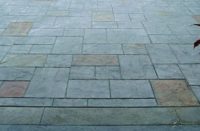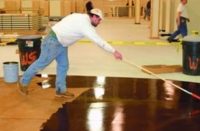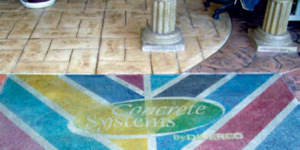Some years back I had the opportunity to listen to a speech on motivation given by retired U.S. Army General Barry McCaffrey. At the end of his speech he made a statement that has stuck with me to this day. He ended by saying, “Be an expert.” He was stressing the fact that too many people get caught up in trying to be all things to all people, instead of focusing in on what they are good at and becoming an expert in that one area.
This message crosses over into all industries and professions. It really hit home when I thought about how it relates to decorative concrete, especially in the application of stains and dyes. (For ease of reading and clarity, I will be referring to all types of stains and dyes as “stains.”) Recently I dealt with troubleshooting a stain issue, and got to thinking that over the last three to five years the decorative industry has grown in so many directions, applicators seem to have gotten away from being an expert at the basics or what they do best. New innovations and a sour economy have driven applicators to look for new and alternative products and markets to provide additional revenue. I am not saying that innovation and trying new things is bad. In fact, applicator innovation is one of the major catalysts behind new product development in the decorative industry over the last 20 years. What I am saying is that as you expand your product offerings, don’t forget what got you to the point where you are today.
In regard to stains, let’s take a minute to go over the basics that should occur on every stain job, as well as how to avoid or repair some of the more common stain issues in the industry.
Stained concrete has been around for close to 100 years. About 25 years ago companies such as L.M. Scofield Co. and Increte Systems began marketing the idea of stained concrete as an alternative to common hard-surface flooring options. The idea stuck, and over the last decade stained concrete became the new and innovative trend in both commercial and residential flooring. Today there are more than 30 companies manufacturing or marketing different types of concrete stain. Throw in polishing, eco-friendly stains, and any numbers of supposed “new” stain technologies, and we end up with today’s stain marketplace – many choices, lots of competition, and lots of different finishes and colors to choose from. How do you weed through the choices to come up with what works best for you?
This is where “being an expert” comes into play. An expert knows his products, knows his market, and is able to offer solutions to customers within his area of expertise.
Five steps
So, keeping in mind the idea of “being an expert,” let’s go over the key steps of any stain project.
Surface preparation: Do a water test to determine how fast and readily water penetrates into the concrete. Anything longer than three seconds, and additional surface preparation may be necessary. Surfaces need to be free and clear of all dirt, oil, grease, cures, sealers and other contamination.
Samples: The cheapest form of insurance any stain applicator can buy. Almost all stain manufacturers and distributors provide samples, so there really is no reason not to do a job-site sample. Find as inconspicuous a place as possible, and put the stain down on the actual job-site floor.
Application: Keep it easy and simple. Instead of getting caught up in multiple colors and exotic complicated designs, be an expert at what sells – one color with a quality sealer that is easy to maintain. Unlike paint, less is more when applying stains. Strive to hit the minimum square footage coverage rates, and think thin coats.
Cleaning and/or neutralizing: Depending on the type of stain system you are using, anywhere from aggressive chemical neutralization to a light damp wipe will be needed. Don’t skip or skimp on this step. Leaving residue behind leads to sealer delaminating or premature sealer failure.
Sealing and maintenance: You get what you pay for when it comes to sealers. I recommend you use a quality sealer and stay away from the less-expensive cure-and-seal products. For interior work, consider using one of the new polyaspartic or polyurea sealers for faster turnaround and a more durable finish than traditional epoxy and polyurethane sealers. Of course, you can’t go wrong when it comes to price and performance with a high-quality acrylic sealer followed by multiple finish (wax) coats.
Five issues
Getting back to basics and establishing a set standard of application is a great way to reduce callbacks, but as anyone who has stained concrete knows, it is not a guarantee for success. Every piece of concrete is different, and each stain project presents its own unique circumstances and idiosyncrasies. Let’s take a look at the five most common issues and how to avoid and repair them.
Lack of penetration:All stains, no matter the chemistry or look, need to penetrate into the concrete for proper adhesion. Failure presents itself as the stain drying on the surface, with all or some coming off during the cleaning process.
I know some expert stain applicators who sand or grind any and all slabs prior to staining. They just don’t mess around with the variables, and they build the surface preparation right into their bid. If you find yourself in a situation where the stain did not take, consider a light sanding to open the slab. You also may need to consider a chemical cleaning. If you do go the route of acid, make sure it is diluted at least 10-to-1, and neutralize the surface after any acid wash.
Wrong color: What happens when the job is done and the client refuses to pay because the color is not correct? This problem is more about expectation management than anything else. As an expert applicator, you know how to sell your services and manage your client’s expectations so they understand stains are as much art as science. A properly managed customer knows to expect color variations, and even if the color is off or flat-out wrong, you are dealing with someone who has been warned, versus an irate homeowner who now claims their life and home is ruined. Do your samples, manage your client’s expectations, and get approval before sealing. If you do need to make a color change, it is easier before you seal. If the sealer has to come off, chemically stripping or mechanically grinding are the two options. A solvent or mild acid will usually pull stains out of the concrete if, as a last resort, it all has to come off.
Color walking off: In high-traffic areas stain can get walked off. Penetrating stains live in the paste top of the concrete. If the paste is worn down with continuous high traffic, foot or otherwise, the color goes with it. Using a sealer that meets the demands of the floor is critical to long-term success and floor life. An expert also knows when stain is not a good idea, and may recommend another flooring option or walk away from the job.
Doing repair work on high-traffic or worn areas requires as much art as science. All residual sealer needs to be removed and the floor thoroughly cleaned. A test to determine which type of stain or colorant will work needs to be performed. Sometimes the stain that was originally used will not work in a restain situation. Using other types of tints or dyes may be required to blend the worn area into the nonworn sections of the floor. Once the repair has been made, establishing a good maintenance program with sealers and waxes that can handle the level of traffic is critical to not repeating the walk-off scenario.
Scuffs and black marks: Acrylic sealers tend to “black-mark” more than polyurethanes, and not all acrylics will black-mark the same. Black marks occur when the plastic or rubber of shoes or tires is softer than the sealer. The sealer grabs at the shoe or tire, especially when friction is high (turning tires, scuffing shoe soles) and some of the material remains on the floor. These black scuffs are usually pretty easy to remove with soap and water and gentle scrubbing. More stubborn stains may require a mild solvent such as rubbing alcohol.
Aggressive black scuffs may actually be burn marks caused by friction that exceeds the melting-point temperature of the sealer. A car tire spinning or a heavy object skidding across the sealer surface can cause these scuffs and burns. Since the sealer has actually been damaged, the scuffed section usually needs to be chemically or mechanically removed and the areas resealed.
Lack of maintenance: All stained floors require some level of maintenance. Even polished and stained floors require some minor cleaning and occasional buffing to keep them looking their best. Too often I come across angry customers who were never informed that regular maintenance would be needed to keep their stained floor looking good. The expert stain installer not only manages expectations, but also provides written maintenance guidelines to the client so they know upfront what is involved regarding future floor maintenance.
Long-term maintenance is as important as the actual installation. Consider offering maintenance services on a regular basis as a new source of revenue. Maintenance for interior stained floors consists of multiple finish (wax) coats that can be buffed and reapplied as needed. Repair for a stained floor that has been lacking maintenance can consist of anything from a good clean and wax to stripping all the way down to the stained concrete and starting the sealing and waxing process over. If you can catch the floor before the sealer is compromised, typically a good cleaning and waxing is all that is needed.















